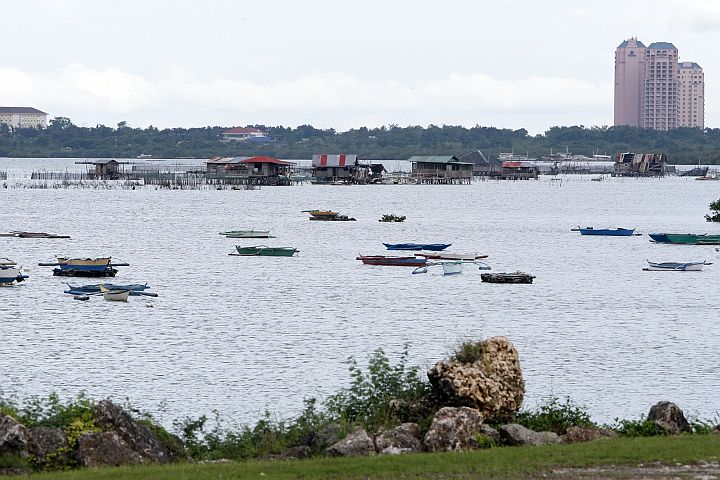
A view of the Mactan Channel covering barangays Ibo, Buaya and Mactan. These barangays were covered in the proposed Lapu-Lapu City reclamation project that was turned down by DENR.
Lapu-Lapu, Cordova among 11 Cebu LGUs with reclamation plans
At least 10 local governments in Cebu want to embark on land reclamation but so far, no permit has been issued by the Department of Environment and Natural Resources (DENR) to proceed.
Only Lapu-Lapu City has sent an application to the DENR 7 for a proposed 400-hectare reclamation that will cover five coastal barangays in the north Mactan.
This was returned in December for lack of required papers.
“We are returning herewith the entire records of the (Application for Presidential Proclamation of Mactan North Reclamation Development Authority) on the ground that there is a lack of the following requirements,” read the letter of Regional DENR Executive Director Isabelo Montejo dated December 16, 2014.
Lapu-Lapu City was asked to provide an approved survey plan, a panoramic view of the area applied for, a clearance from the Department of Tourism (DOT) and clearance from the Cebu Port Authority.
A reclamation project requires a massive investment, and government requirements, including an Environmental Impact Assessment.
At yesterday’s 888 News Forum, DENR-7 spokesman Eddie Llamedo said the DENR hasn’t issued any permits for any reclamation projects in Central Visayas.
“For now there is no pending application for a reclamation for the entire Central Visayas,” Llamedo said.
Several towns are looking into reclamation projects to earn more revenue, spur the local economy and provide jobs.
Aside from Lapu-Lapu City, reclamation projects are also proposed in the cities of Bogo, Mandaue, Naga and Toledo as well as towns of Consolacion, Cordova, Compostela, and San Remigio in the north, and Minglanilla and Boljoon in the south.
Last month, the Lapu-Lapu City government announced it has started pre-reclamation activities such as hole boring to determine the terrain in barangays Ibo, Buaya, Mactan and Punta Engaño and plans to launch the P20-billion project later this year, according to project manager and lawyer Michael Dignos.
The plan calls for the creation of four artificial islands connected with seven bridges. The project is a joint venture between the Lapu-Lapu city government and a Dutch consortium led by Royal Boskalis International.
Application
Toledo City awarded a contractor to work on a breakwater which Toledo City Mayor John Henry Osmeña said is part of the initial phase of an 11-hectare reclamation project in barangay Poblacion.
Meanwhile, Cordova town in Mactan is proposing the biggest reclamation project in the country in 1,500 hectares of foreshore land southwest of Mactan island.
A Cebu Provincial Board (PB) resolution was passed to support the project, a joint-venture project with SM Prime Holdings Inc. But no application has reached the DENR yet.
“If the DENR is bypassed, a special patent (for the land) cannot be issued. It means that you cannot use the reclaimed area for industrial, commercial and other uses so they cannot do anything with the property,” Llamedo said.
National law
If actual work starts without DENR approval, local government officials risk being charged with violating the Clean Water Act, Philippine Environment Code, Fisheries Code among others, Llamedo said.
The Marine Pollution Decree also requires an environment impact assessment for projects that affects the quality of the environment.
Lawyer Gloria Estenzo-Ramos of Oceana Philippines which has opposed plans for a Toledo city reclamation because the area falls within the protected Tañon Strait said any reclamation project must be covered by a national law.
She said a reclamation project would cause a change in the jurisdictional boundaries of an LGU and thus require a plebiscite.
“It must be covered by a national law because it entails an alteration of boundaries which is the basis for the Internal Revenue Allotment (received by an LGU from the national government),” Ramos said.
Unplanned development
Fisherfolk must also be properly consulted since they will be affected in any reclamation projects.
“Municipal fisherfolk in Cordova are against reclamation because fishing is their means of livelihood,” said Regional Director Allan Poquita of the Bureau of Fisheries and Aquatic Resources (BFAR).
Environment advocates called for a halt on any reclamation activities, saying they severely damage the marine ecosystem.
“These unplanned coastal development should end. Everyone should help in putting a stop to this because it is our future that is at stake here. There must be pressure from the citizenry to stop these,” Ramos said.
She said most fishermen they interviewed along the Tañon Strait said their fish catch was declining and that they earn an average of P1,500 a month only because of a smaller fish catch.
Visual assessment
Joan Dulhao, vice president of Sea Knights, a group engaged in marine conservation, said the word reclamation was a misnomer.
“Why are they calling it reclamation when there is nothing to reclaim? It belongs to the sea,” Dulhao said.
Last Saturday, Sea Knights divers went underwater to assess conditions in the bay of barangay Poblacion in Toledo City where the reclamation project is proposed.
While a DENR protected area supervisor and Mayor Osmena said the project site is silted, and devoid of mangroves or marine life, divers said they saw sea grass beds, small fish, seahorses and a few corals that could still be “rehabilitated”.